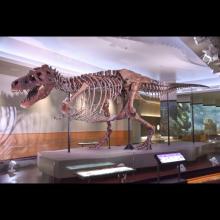Tyrannosaurus rex
Common name:
T-rex
Genus:
Tyrannosaurus
Family:
Tyrannosauridae
Suborder:
Theropoda
Tyrannosaurus rex
Common name:
T-rex
Genus:
Tyrannosaurus
Family:
Tyrannosauridae
Suborder:
Theropoda
Tyrannosaurus rex
Common name:
T-rex
Genus:
Tyrannosaurus
Family:
Tyrannosauridae
Suborder:
Theropoda
Family-Animalia: Tyrannosauridae
Tyrannosauridae (or tyrannosaurids, meaning "tyrant lizards") is a family of coelurosaurian theropod dinosaurs that comprises two subfamilies containing up to fifteen genera, including the eponymous Tyrannosaurus. The exact number of genera is controversial, with some experts recognizing as few as three. All of these animals lived near the end of the Cretaceous Period and their fossils have been found only in North America and Asia.
Although descended from smaller ancestors, tyrannosaurids were almost always the largest predators in their respective ecosystems, putting them at the apex of the food chain. The largest species was Tyrannosaurus rex, the most massive known terrestrial predator, which measured over 13 meters (43 ft) in length and according to most modern estimates up to 8.87 metric tons (9.78 short tons) in weight. Tyrannosaurids were bipedal carnivores with massive skulls filled with large teeth. Despite their large size, their legs were long and proportioned for fast movement. In contrast, their arms were very small, bearing only two functional digits.
Unlike most other groups of dinosaurs, very complete remains have been discovered for most known tyrannosaurids. This has allowed a variety of research into their biology. Scientific studies have focused on their ontogeny, biomechanics and ecology, among other subjects.

